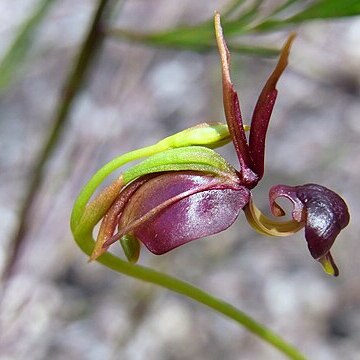Deciduous, terrestrial orchids growing in small, loose to spreading, clonal colonies. Leaf single, basal, ground-hugging to upright, long and narrow or short and relatively broad, glabrous, often withered by flowering time. Racemes 1-to multi-flowered; peduncle extremely thin, wiry. Flowers non-resupinate, dark or dull-coloured, each resembling a bird or insect. Tepals free, narrow, inconspicuous, mostly reflexed out of the way. Labellum attached to column base or apex of column foot by an actively motile, elastic claw. Labellum lamina small, unlobed. Callus shaped like duck’s head and beak, smooth or bearing shiny black warts/calli, projected like an insectiform lure. Column appressed or at right angles to ovary, the curved, broad wings forming a deep, concave basin. Pollinia 4, mealy, yellow, no viscidium.

